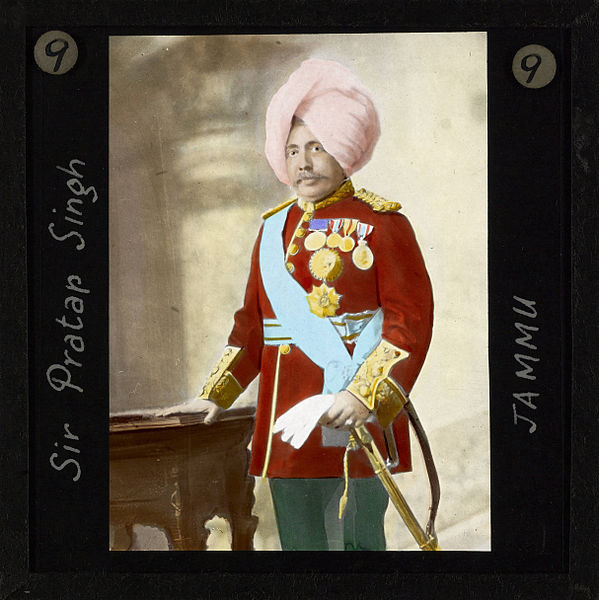Maharaja Pratap Singh’s era was a period of enlightenment for his subjects, particularly for Kashmiris. He did a lot towards establishing local self governing bodies, democratic processes, educational systems, health care & hygiene and infrastructure development during his rule.
Here are some interesting facts to know about Maharaja Pratap Singh, the third Dogra ruler, ruled Jammu & Kashmir for 40 years from 1885 to 1925, the longest of the all the Dogra emperors:
-
- During the time of Pratap Singh, the first major step of improvement was taken in 1889 when the Jhelum Valley Cart Road, “the most wonderful mountain road in the world”, from Kohala to Baramulla was completed. It was extended to Srinagar in 1897. In 1922, another great highway, the Banihal Cart Road, which connected Srinagar, the summer capital, with Jammu,the winter capital of the state was thrown open to the public.
Remembering Maharaja Pratap Singh Ji on his Birth Anniversary. Seen here with his brother Raja Amar Singh Ji (Chief of Jammu & Kashmir Army) performing Chaddi Puja at Chandanwari during Amarnath Yatra, 1898. pic.twitter.com/TRUl2pV8p2
— Vikramaditya Singh (@vikramaditya_JK) July 18, 2019
- In 1887, the State Government carried out the first land settlement. As a result, the rights of the agriculturists were clearly’ defined and the state’s demand was fixed for ten years. “Begar” or forced labour in its more objectionable form was abolished.
- In 1898, Pratap allowed for the construction of the Shri Pratap Singh Museum in Srinagar.
- By 1912 practically every tehsil and district was settled either for the first time or in revision. The land settlement gave much needed security to the cultivators and became responsible for their increasing prosperity. The revenue of the state also increased by more than 100 per cent.
- A model agricultural farm was set up at Srinagar for the spread of knowledge about the scientific methods of cultivation. Establishment of the Department of Agriculture and the introduction of Cooperative Societies were the other measures taken up to further improve the lot of the cultivators.

- Jammu and Kashmir is rich in forests. But till the accession of Pratap Singh, practically nothing had been done to exploit these on scientific lines. In 1891, the State established the Forest Department which soon began to give a very good account of itself. Its surplus revenue for the first year was about a quarter of million of rupees.
- Efforts were made to popularise education. In pursuance of the suggestions made in the report of 1916, many changes were made in the system of education. A number of new schools for both boys and girls were also opened. The imparting of education in the primary schools was made free.
- One degree college each at Jammu (Prince of Wales College, established in 1907, and Srinagar (Sri Pratap College established in 1905) and Amar Singh Technical Institute at the latter (1914) and Sri Pratap Technical School at the former (1924)16 were maintained to meet the demands for higher education. By 1938, Sri Pratap College, with 1187 students on its rolls, achieved the distinction of being the second largest college affiliated to the Punjab University.
Tribute to Maharaja Pratap Singh on his 170th Birth Anniversary. His 40 year reign was the longest among Dogra rulers of Jammu & Kashmir (1885-1925) that saw many development and social welfare measures. He was widely respected by all sections of society across the state. pic.twitter.com/clheXUzNhv
— Vikramaditya Singh (@vikramaditya_JK) July 18, 2018
- Modern hospitals for both males and females were also established at Srinagar and Jammu. In other towns and important villages, medical dispensaries under the charge of qualified doctors were opened. These establishments went a long way in improving the health of the people.
- Besides, agriculture, sericulture, viticulture and horticulture were given great encouragement, and these made much progress going onto become flourishing state industries. A silk factory set up at Srinagar attained the distinction of being “the largest of its kind in the world” .
- During the time of Pratap Singh, the first major step of improvement was taken in 1889 when the Jhelum Valley Cart Road, “the most wonderful mountain road in the world”, from Kohala to Baramulla was completed. It was extended to Srinagar in 1897. In 1922, another great highway, the Banihal Cart Road, which connected Srinagar, the summer capital, with Jammu,the winter capital of the state was thrown open to the public.
Pratap Singh left no issue of his own when he died on 23 September 1925, but he was succeeded by his nephew Hari Singh, son of Raja Amar Singh.


